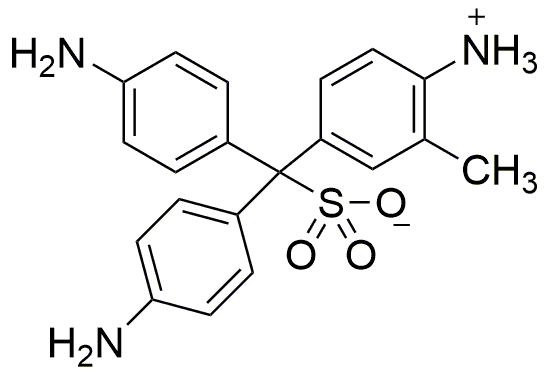Schiff’s fuchsin-sulfite reagent is widely utilized in research focused on:
- Histology and Microscopy: This reagent is essential for staining tissues, particularly in identifying aldehyde groups in biological samples, which helps in the visualization of cellular structures under a microscope.
- Microbiology: It is used to detect and differentiate various microorganisms, especially in identifying bacteria that produce polysaccharides, aiding in the diagnosis of infections.
- Environmental Testing: The reagent plays a role in assessing water quality by detecting the presence of aldehydes, which can indicate pollution or contamination in aquatic environments.
- Food Industry: It is applied in food testing to identify preservatives and additives, ensuring compliance with safety regulations and maintaining product quality.
- Research and Development: In chemical research, it serves as a valuable tool for synthesizing and characterizing new compounds, particularly in organic chemistry, enhancing the understanding of chemical reactions.
Informations générales
Propriétés
Sécurité et réglementation
Applications
Schiff’s fuchsin-sulfite reagent is widely utilized in research focused on:
- Histology and Microscopy: This reagent is essential for staining tissues, particularly in identifying aldehyde groups in biological samples, which helps in the visualization of cellular structures under a microscope.
- Microbiology: It is used to detect and differentiate various microorganisms, especially in identifying bacteria that produce polysaccharides, aiding in the diagnosis of infections.
- Environmental Testing: The reagent plays a role in assessing water quality by detecting the presence of aldehydes, which can indicate pollution or contamination in aquatic environments.
- Food Industry: It is applied in food testing to identify preservatives and additives, ensuring compliance with safety regulations and maintaining product quality.
- Research and Development: In chemical research, it serves as a valuable tool for synthesizing and characterizing new compounds, particularly in organic chemistry, enhancing the understanding of chemical reactions.
Documents
Fiches de données de sécurité (FDS)
La FDS fournit des informations de sécurité complètes sur la manipulation, le stockage et l’élimination du produit.
Spécifications du produit (PS)
Le PS fournit une description complète des propriétés du produit, notamment sa composition chimique, son état physique, sa pureté et les exigences de stockage. Il détaille également les plages de qualité acceptables et les applications prévues du produit.
Certificats d'analyse (COA)
Recherchez des certificats d'analyse (COA) en saisissant le numéro de lot du produit. Les numéros de lot et de lot se trouvent sur l'étiquette d'un produit, après les mots « Lot » ou « Lot de fabrication ».
Numéro de catalogue
Numéro de lot/série
Certificats d'origine (COO)
Ce certificat d'exploitation confirme le pays dans lequel le produit a été fabriqué, et détaille également les matériaux et composants utilisés et s'il est issu de sources naturelles, synthétiques ou autres sources spécifiques. Ce certificat peut être requis pour les douanes, le commerce et la conformité réglementaire.
Numéro de catalogue
Numéro de lot/série
Fiches de données de sécurité (FDS)
La FDS fournit des informations de sécurité complètes sur la manipulation, le stockage et l’élimination du produit.
DownloadSpécifications du produit (PS)
Le PS fournit une description complète des propriétés du produit, notamment sa composition chimique, son état physique, sa pureté et les exigences de stockage. Il détaille également les plages de qualité acceptables et les applications prévues du produit.
DownloadCertificats d'analyse (COA)
Recherchez des certificats d'analyse (COA) en saisissant le numéro de lot du produit. Les numéros de lot et de lot se trouvent sur l'étiquette d'un produit, après les mots « Lot » ou « Lot de fabrication ».
Numéro de catalogue
Numéro de lot/série
Certificats d'origine (COO)
Ce certificat d'exploitation confirme le pays dans lequel le produit a été fabriqué, et détaille également les matériaux et composants utilisés et s'il est issu de sources naturelles, synthétiques ou autres sources spécifiques. Ce certificat peut être requis pour les douanes, le commerce et la conformité réglementaire.


